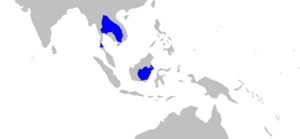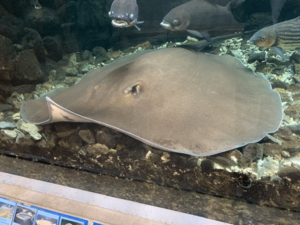Giant freshwater stingray facts for kids
Quick facts for kids Giant freshwater stingray |
|
|---|---|
 |
|
| Conservation status | |
| Scientific classification | |
| Genus: |
Urogymnus
|
| Species: |
polylepis
|
 |
|
| Geographic range (excludes populations not confirmed as extant and/or conspecific) | |
| Synonyms | |
|
|
The giant freshwater stingray (Urogymnus polylepis) is a huge stingray that lives in rivers. It is also known by its older name, Himantura chaophraya. This amazing animal is found in large rivers and estuaries in Southeast Asia and Borneo.
It is one of the biggest freshwater fish in the world. This stingray can grow up to 2.2 m (7.2 ft) wide and weigh as much as 300 kg (660 lb). It has a thin, oval body that is widest at the front. Its snout is sharp and sticks out. The tail is thin and looks like a whip, without any fins on it. The ray is usually grayish-brown on top and white underneath. The bottom of its fins has wide, dark stripes.
The giant freshwater stingray lives on the bottom of rivers. It likes sandy or muddy areas. It hunts for small fish and other tiny creatures like crabs and snails. Female stingrays give birth to live young, usually one to four pups at a time. The mother feeds her babies with a special "uterine milk" inside her body. This species is facing many threats. People fish for it for food, for fun, and for aquariums. Its home is also being damaged and broken up by human activities. Because of these problems, its numbers have dropped a lot, especially in central Thailand and Cambodia. The International Union for Conservation of Nature (IUCN) lists the giant freshwater stingray as Endangered.
Contents
How it Got its Name
The giant freshwater stingray was first described by a Dutch scientist named Pieter Bleeker in 1852. He named it polylepis, which means "many scales" in Greek. He put it in the group Trygon.
For many years, Bleeker's description was not widely known. So, in 1990, two other scientists, Supap Monkolprasit and Tyson Roberts, described it again. They gave it the name Himantura chaophraya, which became very popular.
Later, in 2008, scientists Peter Last and B. Mabel Manjaji-Matsumoto found out that T. polylepis and H. chaophraya were actually the same species. Since Bleeker's name was published first, the correct scientific name for this stingray became Himantura polylepis. Sometimes, people also call it the giant freshwater whipray.
Scientists are still studying similar stingrays in different parts of Asia and Australia. They want to know if some of these are the same species or different ones. For example, Australian freshwater stingrays are now called Urogymnus dalyensis. More research is needed to understand all the different types of giant freshwater stingrays.
What it Looks Like
The giant freshwater stingray has a thin, oval-shaped body. It is a bit longer than it is wide. The widest part of its body is near the front. Its snout is long and pointed, sticking out past its body. The eyes are tiny and set far apart. Behind the eyes are two large holes called spiracles.
Its mouth is small and curved. Inside the mouth, there are small, rounded teeth that form a flat surface, like pavement. It has five pairs of gill slits on the underside of its body. The pelvic fins are small and thin.
The tail is thin and round, like a whip. It is about 1.8 to 2.5 times longer than the body. There are no fins on the tail. It has a single, sharp stinging spine on the top of its tail, close to its body. This spine can be up to 38 cm (15 in) long, making it the longest stingray spine in the world!
The top of the stingray's body is covered in tiny, rough bumps called denticles. It also has a line of larger bumps down the middle of its back. The stingray is usually plain grayish-brown on top, sometimes with a yellowish or pinkish color near the edges of its fins. Its skin is covered in a dark brown slime. The underside of its body is white. It has wide, dark stripes on the back edges of its pectoral and pelvic fins. The tail is black behind the sting.
This stingray can grow to be at least 1.9 m (6.2 ft) wide and 5.0 m (16.4 ft) long. Some reports from the Mekong and Chao Phraya Rivers say individuals have weighed 500–600 kg (1,100–1,300 lb). It is even possible for them to reach 1,500 kg (3,300 lb) or 2,000 kg (4,400 lb). This makes it one of the largest freshwater fish on Earth.
In June 2022, a giant freshwater stingray caught in the Mekong River broke the record for the largest freshwater fish ever recorded. It weighed 300 kg (660 lb) and was 3.98 m (13.1 ft) long and 2.2 m (7.2 ft) wide.
Where it Lives
The giant freshwater stingray lives in several large rivers and their nearby estuaries in Indochina and Borneo. In Indochina, you can find it in the Mekong River, as well as the Chao Phraya, Nan, Mae Klong, Bang Pakong, and Tapi Rivers in Thailand. It used to be found in Bueng Boraphet, but it is now gone from there.
In Borneo, this stingray lives in the Mahakam River in Kalimantan and the Kinabatangan and Buket Rivers in Sabah. It is said to be common in the Kinabatangan River. Although it was reported in Sarawak, recent studies have not found it there. Also, it has not been seen in Java lately, even though the first specimen was found there.
Historically, there were reports from the Ganges River in India. In 2022, it was confirmed to be in the Kaladan and Mayu rivers in Myanmar.
The groups of stingrays in different rivers are probably separated from each other. Even though they can live in brackish water (a mix of fresh and salt water), there is no proof they cross salty ocean waters. This stingray lives on the bottom of rivers, preferring sandy or muddy areas. Surprisingly, it can sometimes be found near busy cities.
Life and Habits
The giant freshwater stingray eats small fish and other creatures that live on the river bottom. These include crustaceans like crabs and molluscs like snails. It can find its food using special sensors called ampullae of Lorenzini, which detect electricity. Sometimes, these stingrays are seen near the edge of rivers, possibly looking for earthworms to eat.
This stingray gives birth to live young. The baby stingrays first get food from a yolk sac. Then, the mother provides them with a special "uterine milk" to help them grow. This species does not travel between fresh and salt water to complete its life cycle.
A mother stingray usually has one to four babies at a time. Newborn stingrays are about 30 cm (12 in) wide. Pregnant females are often found in estuaries, which might be safe places for the young to grow up.
How Humans Interact with it
The giant freshwater stingray is not usually aggressive. However, its sting is covered in a poisonous slime and can even pierce bone.
Across its home range, local fishers often catch this stingray by accident. They use long fishing lines, and sometimes nets or traps. It is known to be very hard to catch. A hooked ray might bury itself deep in the mud, making it almost impossible to pull up. It can also drag boats for long distances or even pull them underwater!
People use the ray's meat and its cartilage. Large stingrays are cut into pieces and sold. Adult rays that are not used for food are often killed or hurt by fishers anyway. In some rivers, like the Mae Klong and Bang Pakong, the giant freshwater stingray is also becoming a target for sport fishing and for display in public aquariums.
These activities are a worry for the stingray's future. Sport fishing can be harmful if fishers do not release the rays carefully. Also, these stingrays do not live well in captivity, so putting them in aquariums is not good for them.
Threats and Conservation
The biggest dangers to the giant freshwater stingray are too much fishing and damage to its home. This damage comes from cutting down forests, building on land, and building dams. Dams also split up the stingray populations, which means they have less variety in their genes. This makes them more likely to die out.
Because the giant freshwater stingray does not have many babies, it cannot recover quickly from these human pressures. In central Thailand and Cambodia, the number of stingrays has dropped by 30–50% in the last 20–30 years. In some places, the decline has been as high as 95%. The size of the stingrays caught has also gotten much smaller. For example, in Cambodia, the average weight of a caught ray went from 23.2 kg (51 lb) in 1980 to just 6.9 kg (15 lb) in 2006.
We do not know much about the stingray populations in other areas, like Borneo. Because of the clear drops in numbers, the International Union for Conservation of Nature (IUCN) has listed this species as Endangered worldwide. In Thailand, it is considered Critically Endangered.
In the 1990s, the Thai government started a program to breed this and other freshwater stingrays in captivity. The goal was to help their numbers grow until their natural homes could be fixed. However, this program was stopped by 1996.




